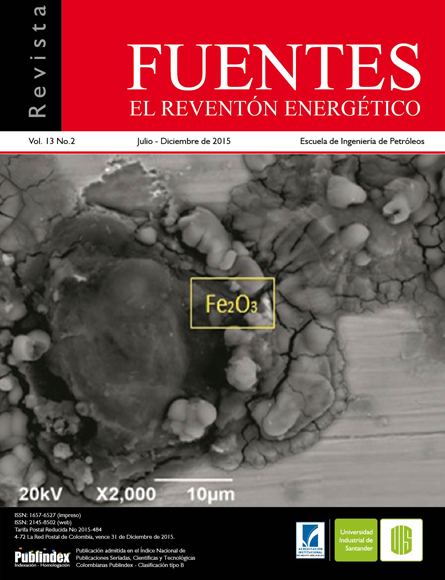Publicado 2015-12-03
Palabras clave
- Fracturamiento Hidráulico,
- Fluido de fractura,
- Flowback,
- Polímero,
- Trazadores químicos
- Colorantes,
- Adsorción,
- Desplazamiento en medio poroso ...Más
Cómo citar
Resumen
En esta investigación, se evaluaron siete sustancias químicas seleccionadas de las familias de sales inorgánicas y colorantes usados normalmente en hidrología, como potenciales trazadores para un fracturamiento hidráulico, implementando métodos analíticos económicos para su detección y cuantificación y que se puedan realizarse insitu. A partir de los ensayos de adsorción, compatibilidad con el gel de fractura y los fluidos de formación, así como ensayos de desplazamiento en medio poroso, se identificaron tres sustancias que respondieron aceptablemente, tras ser sometidas a las condiciones físicas y químicas de un proceso de fractura hidráulica lo que las habilitaría para su uso como trazadores.
Descargas
Referencias
2. Ahma, S., Basak, K., and Hossein, K. “Analysis of Chemical tracer Flowback in Unconvectional Reservoirs”. Paper SPE -171656-MS presented at the SPE/SCUR Unconvectional Resource. Alberta Canada, 30 September – 2 October. 2014.
3. Asadi, M., Woodroof, R. “Comparative Study of Flowback Analysis Using Polymer Concentrations and Fracturing Fluid Tracer Methods”: A Field Study. SPE Journal Paper No 101614 December 2006.
4. Asadi, M., Woodroof, R. William S. “Monitoring Fracturing Fluid Flowback with Chemical Tracers: A Field Case Study”. Paper SPE 77750 presented at the SPE Annual Technical Conference and Exhibition held in San Antonio, Texas, 29 September-2 October 2002.
5. Asadi, M., WoodrooF, Robert A., and Dumas, Donald Jr. “Post-Frac Analysis Based on Flowbacks Results Using Chemical Frac-Tracers”. IPTC International Petroleum Technology Conference Paper No 11891 December 2008.
6. Carrascal, F. A., Pachón, Z. & Molina, D. R. “Post-fracturing treatments design to redress the damage caused by fracturing fluid polymers”. CT&F - Ciencia, Tecnología y Futuro, 2014.
7. Du, Y., and Guan, L. “Interwell Tracers Test: Lesson Learned From Past Field Studies”. Papers SPE 93140 presented at the Asia Pacific Oil & Gas Conference and Exhibition, Jakarta, 5 – 7 April. 2005.
8. Hutchins, R.D., and Dovan, H.T. “Aqueous Tracer for Oilfield Applications”. Papers SPE 21049 presented at the SPE International Symposium on Oilfield Chemistry, Anaheim, 20 - 22 February 1991.
9. Mcintyre, F.J. Polkoswski, G.A., Pow, M.J. “Radioactive Tracers Monitor Solvents Spreading in Rainbow Vertical Hydrocarbon Miscible Flood”. SPE Reservoir Engineering. February 1998.
10. Melo, M.A., Holleben, C.R., and Almeida, A.R. “Using Tracers to Characterize Petroleum Reservoirs: Application to Carmopolis Field, Brazil”. Paper SPE 69474, presentation at the SPE Latin American and Caribbean Petroleum Engineering Conference held in Buenos Aires, Argentina, 25–28 March 2001.
11. Pope, D., et al. “Field study of guar removal from hydraulic fractures”. Paper SPE 31094 presented at the SPE International Symposium on Formation Damage Control. Lafayette, La, Feb. 14-15. 1995.
12. Reinicke A., Rybacki E., Stanchits S., Huenges E. and Dresen G. “Hydraulic fracturing stimulation techniques and formation damage mechanismImplications from laboratory testing of tight sanstone- proppanyt system”. Chemieder Erde, 2010.
13. Shan, S.N, Lord D.L, and Tan, HC. “Recent advances in the fluid mechanics and the fluid rheology of fracturing fluid”. EN: SPE Journal paper N° 22391 March, 1992.
14. Sullivan, R., et al. “Optimizing Fracturing Fluid Cleanup in the Bossier Sand Using Chemical Frac Tracers and Agressive Gel Breaker Deployment”. SPE Journal Paper No 90030 September 2004.
15. Wang, J., Holditch, S. and McVay., D. “Effect on Gel Damage on Fractures Fluid Cleanup and Long Term Recovery in Tight Gas Reservoirs”. Journal of Natural Gas science and Engineering 9, 2012.
16. Wheeler V., Parsons T., “The Application of Radioactive Tracers to Oil Reservoir Water floods Studies”. SPE 13985/1. 1985.
17. Yang, B. H. and Flippen, M. C. “Improved flowback analysis to asses polymer damage”. Paper SPE 37444 presented at the SPE Production Operations Symposium, Oklahoma City, OK, March 9-11. 1997.
